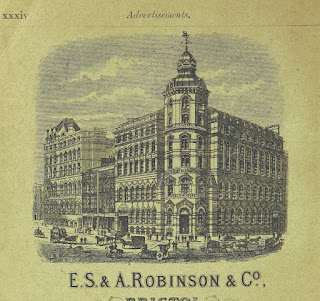How did women cope as Head of Household in 1901?
In this blog, Sarah Villiers examines the lives of women living in Easton, Bristol, in the 1900s. Her study reveals that life was hard for many of these women. Sarah gave a talk about her research at our last Annual Conference in October 2022, which was on Women and Money: A Historical Perspective.
Having recently moved to Easton in Bristol, I found my house had been
built in the early 1910s. I decided to find out more about my neighbours of
that time. I focused on the triangle between three railway lines: to the west, one
still extant near Stapleton Road station; a second (now a cycle path) on the
east; and the third lying across the top of the triangle roughly following part
of Fishponds Road. Most of this area had been market gardens until development
rapidly took place. This period coincided with (was stimulated by?) the whole
area being incorporated into Bristol City in 1897.
Sources
The 1901 census showed a number of households where a woman was identified as Head of Household. Such women often had several children. The census revealed several possible reasons for their being Head of Household. For example, they were widowed; their husbands were working away (eg sailor/soldier, or on the railways); or he had deserted.
A few were singletons. My immediate thought was how did they survive –
depending on a few nearby soup kitchens, church charity, kindness of
neighbours? Specific survival strategies seem to have been adopted: work, take
a lodger, re-marry, or live on their children’s wages if old enough to work
(over fourteen).
Work
If women had a job they were often paid barely half a man’s wage and,
with young children, they needed to work at home. This usually meant some type
of needle work, either by hand or machine. Nearby were several corset
manufacturers (Bayer’s corset factory on Roman Road), clothing factories
(particularly uniforms in Mivart St), as well as other enterprises on Stapleton
Rd. Each of these could provide outwork.
Other work was cleaning domestic or business premises, like Emily Bees, who was
still charring aged ninety. Another possibility was laundry work, either in the
huge laundry and dye works in nearby Mina Rd, St Werburghs, or taking in
washing – some houses had a rear scullery with copper.
A few widows inherited their husband’s business. Elizabeth Prior (twenty nine years old) ran a grocer’s shop which maintained her three young children and eleven year old niece. Nevertheless, she took in a lodger – and then married him!
 |
| E S & A Robinson & Co, paper bag manufacturers, employed many Bristol women. |
Lodgers
If a woman was the main tenant in a house, she could let out rooms. The
lodgers were sometimes workmates, or family members, or strangers. Alma Atwell,
a retired schoolmistress, took in a dress-maker boarder and box-maker lodger.
Or widows became lodgers themselves. Maria Masters (aged twenty eight)
lived on her ‘own means’ with her six year old daughter, and then lodged
with a couple, their son and adult niece. A few widow-lodgers had an occupation
which they could continue: monthly nurse Mary Cox (aged sixty nine) lodged with
a couple and their six children.
Working children
Four such children were vital in Sarah Box’s household of twelve, where
she cared for a husband (described as a ‘moron’), daughter (‘kept at home’),
and five more young children. Widowed Louisa Mitchell continued as a
‘vest-maker’, with seven children. Her three elder daughters moved to
Birmingham to work in a neighbour’s pie-and-peas café, thus increasing income
and decreasing numbers living at home.
Lone Wives
Rare cases of apparent desertion were also revealed. Young bride Ellen
Thomas (aged twenty five) was found lodging with an elderly couple. She later
moved back to her parents with no hint of her husband’s whereabouts. Harriet
Godwin (aged fifty four) lived with two daughters who were paper-bag makers at
Robinson’s, and another who worked as a servant girl. Together they supported a
further four children at school. What is puzzling is that her husband (d. 1913)
and eldest son were doing a series of poorly paid jobs, yet lodged in nearby
Redcliffe.
A further, very sad case was that of tailoress Elizabeth Shute (aged fifty), who was living with six children (aged seven to nineteen). Her husband had frequent short absences
(in 1888, 1890,1899, and 1900). By
1900 Elizabeth had taken over her husband’s grocery shop when her husband
became absent for longer. He was detained at Her Majesty’s Pleasure in
Dartmoor from 1902 to 1917, on account of having carnal knowledge of his own six
year old and of a neighbour’s five year old. Was there sympathy for Elizabeth,
or only shame and stigma? She continued to run the shop for two more years,
then moved to lodgings in ‘downtown’ St George’s where her daughters worked as a
tailoress and chocolate-coater. Elizabeth identified herself as ‘widow’ in 1911,
though her husband died several years later.
Singletons
There were few examples of single women, on their own. These ‘singletons’ sometimes had ‘private’ means’ – perhaps a father had willed money to their daughter. Or they worked, like like cap-maker Elizabeth Howell (aged fifty eight) who, sadly, soon entered the Infirmary, where she died. Others, though married, were sole earners, such as tailoress Emily Vincent (aged fifty five) who cared for her husband (a blinded stonemason). By 1911 she was widowed, on Parish Relief, and lodging above a shop nearby. A few other instances were found where an injured worker received Club Allowance. One lone wife, Alice Lloyd (aged thirty seven and deaf) was supported by army pay from her husband fighting in the Boer war.
Several examples of singletons living with siblings were evident. Bootfitter Susan Payne combined with two sisters who were also bootmakers, while ‘lunatic nurse’ Fanny Stout (aged fifty four) was with her schoolteacher sister (aged forty two).
Looking ahead, the 1911 census gives even richer information. In particular, this included a number of children born alive but having died. This reveals contrasts in survival rates seemingly relating to levels of poverty and overcrowding, eg two streets – one of the earliest and poorest compared to the most recent and richer one – with markedly different infant mortality rates.
There is much more to discover.
Biography
I am a retired university lecturer/fellow who has shifted focus and followed diverse interests.
I have recently published findings from several projects relating to work done with Wells Museum (my most recent abode). These touched on local industries and living conditions and, also, on some special items in the Museum; in particular, the lives of young girls and their literacy education as evidenced through the examples of the Museum’s extensive collection of 18-19th century samplers.
Picture Credits:-
E S & A Robinson & Co, British Library on Flickr, No Known Copyright Restrictions



Comments
Post a Comment